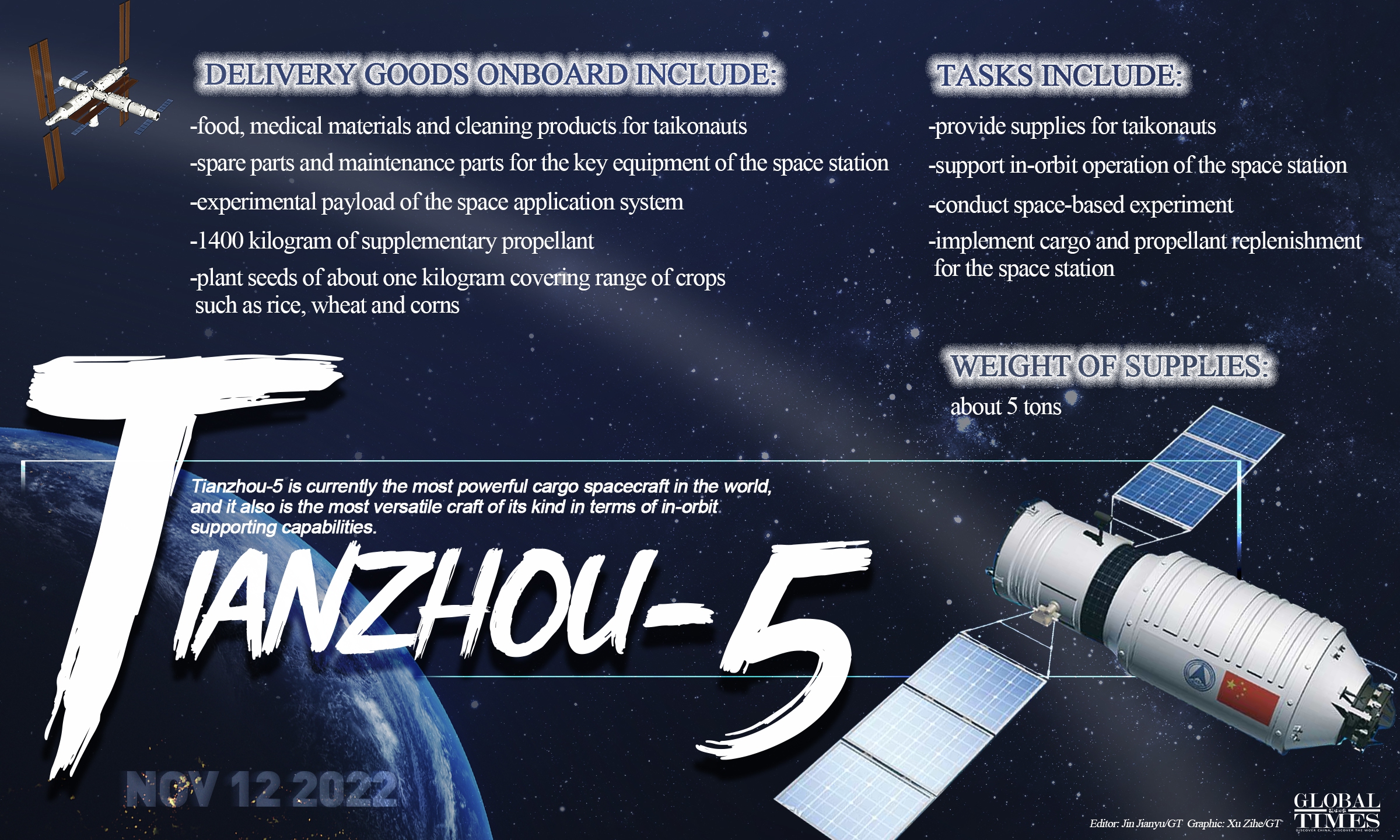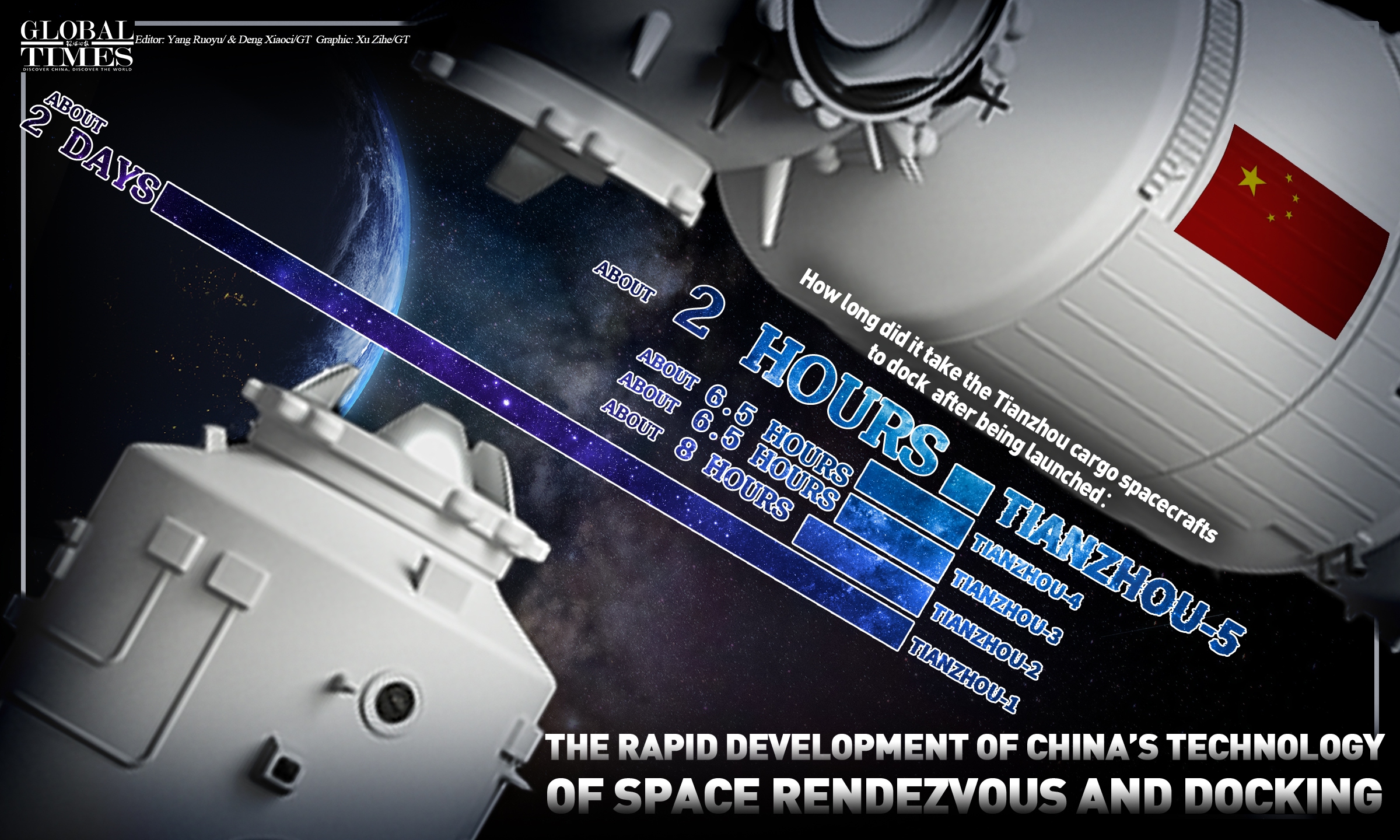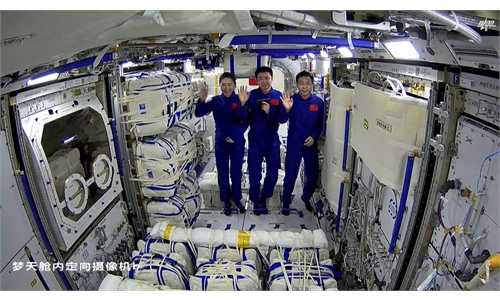China achieves two-hour ultrafast rendezvous in Tianzhou-5 cargo supply mission, setting new world record, laying ground for crewed mission application

Illustration: Xu Zihe/GT
Tianzhou-5 cargo spacecraft smoothly docked with the China's T-Shape Tiangong Space Station about only two hours after being launched earlier from Wenchang Space Launch Site in South China's Hainan Province, marking a new record of the world's fastest launching to docking feat in space for a spacecraft, and showcasing the China speed once again.With the ultrafast rendezvous, Tianzhou-5 cargo spacecraft has broken the record held by Russia's crewed spacecraft Soyuz MS-17. The crewed Russian craft took 3 hours and 3 minutes from launching to docking with the International Space Station on October 14, 2020.
Tianzhou cargo spacecraft series has witnessed a rapid development of China's technology of space rendezvous and docking.
It took Tianzhou-1 about two days to dock with the Tiangong-2 space lab on April 22, 2017. Adopting an autonomous and fast rendezvous and docking technology, Tianzhou-2 docked with China's Tianhe space station core module on May 30, 2021, some eight hours after being launched.

Illustration: Xu Zihe/GT
Following that, China has further reduced the time for the Tianzhou spacecraft delivery run at the space station building stage, and it took about 6.5 hours for Tianzhou-3 and Tianzhou-4 to achieve the feat on September 20, 2021 and May 10, 2022 respectively.
Pang Zhihao, a Beijing-based space expert, told the Global Times that only Russia has pulled off such ultrafast rendezvous before, and now China has not only done it but done it even faster.
Shorter time from launching to docking would save more resources consumed in the process and once it is applied to crewed spacecraft, it will enable even faster space rescue responding to emergency situations, Pang said.
It is likely to become the new norm for the cargo spacecraft missions to the China Space Station with the reliability being further verified before its application in the crewed missions in the future, Pang said, noting that China is making new attempts and boosting its technology advancement in every new launch, showing the courage and confidence of China's manned space programs.
China successfully launched Tianzhou-5 cargo spacecraft to ferry supplies to the China's Space Station, via a Long March-7 carrier rocket from Wenchang Space Launch Site in South China's Hainan Province on Saturday morning at 10:03 am, marking the first launch mission to Tiangong after the completion of the T-shape assembly of the country's first-ever permanent space station.
Tianzhou-5 is currently the cargo spacecraft in service with the most powerful transport capability in the world, and it also is the most versatile craft of its kind in terms of in-orbit supporting capabilities. It is commissioned to carry out tasks including providing supplies for taikonauts, supporting in-orbit operation of the space station, conduct space-based experiment and implementing cargo and propellant replenishment for the space station, Global Times learned from the spacecraft developer, the China Academy of Spacecraft Technology (CAST).
The Tianzhou-5 carries supplies weighing some 5 tons in the delivery run to the China's Tiangong Space Station, which includes food, medical materials and cleaning products for the taikonauts. Also onboard the craft are spare parts and maintenance parts for the key equipment of the space station, the experimental payload of the space application system, and the 1400 kilogram of supplementary propellant, according to a statement the CAST provided to the Global Times.
The cargo spacecraft also carries plant seeds weighing about one kilogram, covering range of crops such as rice, wheat and corns that would be used in space seeding experiments. They will be returned to Earth later with the manned spacecraft and then cultivated on Earth before being put into the market, the CAST said.
Three experimental payloads will be ferried to the orbiting space station with the Tianzhou-5. That includes country's first-ever fuel cell for space application that is also developed by the CAST, which will be used to conduct the country's first fuel cell in-orbit experiment to verify the performance of the fuel cell and to explore how the environment in space, including microgravity, would impact its performance. Such research and study will provide firm support for the development of China's manned moon probe missions in the future, according to the CAST.
China plans to complete the building of Tiangong Space Station and makes it operational within 2022. To achieve that, six space launch missions - two lab modules, Wentian and Mengtian, two Tianzhou cargo spacecraft and two Shenzhou manned spacecraft, are required.
China has executed five of the six missions with perfect success records.
The Saturday launch marked the final mission of the Long March-7 rocket at the space station building stage and also the last launch mission scheduled at the Wenchang Space Launch Site this year.
And according to the rocket developer China Academy of Launch Vehicle Technology (CALT,) the rocket model that is capable of sending payload up to 14 tons to the near-Earth orbit and payload of 9.5 tons to the Sun synchronous orbit when mounting upper stage, will continue launch frequency of twice a year after China's Tiangong Space Station becomes operational.
It can ferry not only Tianzhou-cargo spacecraft but also other satellite payloads and is believed that it will be widely used in the future in the launch missions of medium- and low-orbit satellites.
According to the China Manned Space Agency (CMSA), the Shenzhou-14 crew will be visited by the Tianzhou-5 cargo spacecraft and the Shenzhou-15 manned spacecraft, and two crews of six taikonauts will make China's first direct handover in-orbit.


